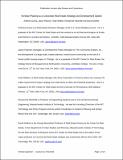Vertical Phasing as a Corporate Real Estate Strategy and Development Option
Author(s)
Guma, Anthony; Pearson, Jason; Wittels, Kate; de Neufville, Richard; Geltner, David M.
DownloadGeltner_Vertical Phasing.pdf (465.1Kb)
OPEN_ACCESS_POLICY
Open Access Policy
Creative Commons Attribution-Noncommercial-Share Alike
Terms of use
Metadata
Show full item recordAbstract
Purpose – The purpose of this paper is to demonstrate the potential value of significant vertical phasing – that is, the addition of five or more stories to an existing building – as a valuable real option in real estate development, in particular for corporate real estate strategy.
Design/methodology/approach – The demonstration is done through in-depth case studies of four major projects in North America: the 24 story, 880,000 square feet expansion of the Health Care Service Corporation building in Chicago; the Court Square Citicorp Campus in New York City; the Bentall Five project in Vancouver; and the Tufts University School of Dental Medicine building in Boston.
Findings – Vertical expansion appears to have significant organizational and logistical advantages for corporate developers, such as the ability to keep staff in one building, and the elimination of the need to relocate with its resulting inconvenience and potential to lose employees. Further, the financial analysis indicates that the option to expand vertically is a reasonable way for corporate developers to access convenient expansion space, while limiting their downside risk. Commercial developers on the other hand may find that the ability to scale back designs in the case of market downturns is particularly valuable. The case studies also confirm by example that the vertical expansion of buildings is technically possible. Although the process of erecting a major new building on top of a fully occupied building is clearly complex, it is not extraordinary difficult so long as the possibility of vertical expansion is built into the original design.
Originality/value – Vertical expansion of buildings has not been appreciated as an attractive feasible option for flexible development of real estate in a risky environment. These case studies and analysis bring this possibility to the attention of the real estate industry and corporate real estate managers.
Date issued
2009Department
Massachusetts Institute of Technology. Department of Urban Studies and Planning; Massachusetts Institute of Technology. Engineering Systems DivisionJournal
Journal of Corporate Real Estate
Publisher
Emerald Group Publishing Limited
Citation
Guma, Anthony et al. “Vertical phasing as a corporate real estate strategy and development option.” Journal of Corporate Real Estate 11.3 (2009): 144-157.
Version: Author's final manuscript
ISSN
1463-001X